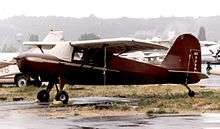Commonwealth Skyranger
| Commonwealth 185 | |
|---|---|
.jpg) | |
| Commonwealth 185 | |
| Role | Utility aircraft |
| Manufacturer | Rearwin, Commonwealth |
| Designer | Gene Salvay and George A. Stark |
| First flight | 9 April 1940 |
The Commonwealth Skyranger, earlier produced as the Rearwin Skyranger, was the last design of Rearwin Aircraft.[1] It was a low-powered two-seat, high-wing taildragger.
Design and development
The Skyranger was developed by Rearwin Aircraft & Engines Co., Inc.,[2] and certificated in 1940[1] (U.S. Approved Type Certificate 729)[2] The Skyranger was originally produced in 1940, as a high-wing light plane seating two people side-by-side. It had a conventional landing gear with a tailwheel. It was constructed with a fabric-covered steel tube fuselage and wooden wing (with a semi-symmetical airfoil cross-section. The Skyranger was powered by a variety of opposed engines made by Continental Motors and the Franklin Engine Company,[3] ranging from 65 to 90 horsepower.[2] It sold for about $2,400.[2]
Comparably configured aircraft, of the era, included the Aeronca Chief (pre-war models), Taylorcraft and Piper J-4 Cub Coupe, and other competitors included the tandem-seating Piper Cub, Interstate Cadet, and Porterfield Collegiate. However, the Skyranger handled very differently from the other planes in its class -- with a "heavy-airplane feel" (heavy controls, exceptional stability), and, with an unusually large vertical stabilizer for its size, was exceptionally susceptible to crosswinds during landing and taxiing.[3][1]
Rearwin Aircraft
Rearwin (at that time Rearwin Aircraft and Engines Co., Inc.) developed the Skyranger at Fairfax Airport in Kansas City, Kansas,[2] Its development in 1940[1] came shortly before the U.S. entered World War II. At that time, the U.S. government was purchasing almost any airplane in the two-seat, 50-90 horsepower class as training aircraft for the Civilian Pilot Training Program ("CPT Program" or "CPTP"), intended to develop tens of thousands of pilots for the possibliity of U.S. involvement in the war. However, unlike its contemporaries heavily used in the CPTP such as the Piper Cub, Taylorcraft, Interstate Cadet, and Porterfield Collegiate, the Skyranger was more challenging to fly and was rejected by the government for CPTP use.[1]
By the start of U.S. involvement in the war, in 1941, Rearwin had produced only 50 Skyrangers[1], and by the end of Rearwin production, it had built just 82 Skyrangers[3] (compared to hundreds or thousands of its competitors' planes[4]) -- 25 of them going to Iran.[3]
Commonwealth Aircraft
In 1942 the Rearwin Airplane Company was purchased by Commonwealth Aircraft of Kansas City, Missouri. In 1946 Commonwealth re-established the construction of the Skyranger at their Valley Stream plant for just one year. It had many minor modifications but was essentially the same aircraft. As the anticipated post-war boom in civil aviation had not then started, Commonwealth went bankrupt in 1947. 275 Skyrangers were built by Commonwealth (Note that Aerofiles.com reports that number as the production quantity -- "POP" -- built by Rearwin[2]).
Serial numbers in the 1500s were built by Rearwin. Serial numbers in the 1600s are Commonwealth 185 Skyrangers.
Specifications (Model 185 Skyranger)

Data from Jane's all the World's Aircraft 1947[5]
General characteristics
- Crew: 2
- Length: 21 ft 9 in (6.63 m)
- Wingspan: 34 ft 0 in (10.36 m)
- Height: 6 ft 7 in (2 m)
- Wing area: 164.6 sq ft (15.29 m2)
- Empty weight: 910 lb (413 kg)
- Gross weight: 1,450 lb (658 kg)
- Fuel capacity: 24 US gal (20 imp gal; 91 l) in two wing tanks
- Powerplant: 1 × Continental C85 4-cyl. air-cooled horizontally-opposed piston engine, 85 hp (63 kW)
- Propellers: 2-bladed fixed pitch wooden airscrew, 6 ft 6 in (1.98 m) diameter
Performance
- Maximum speed: 114 mph (183 km/h; 99 kn)
- Cruise speed: 103 mph (166 km/h; 90 kn)
- Landing speed: 48 mph (42 kn; 77 km/h)
- Range: 600 mi (521 nmi; 966 km)
- Endurance: 5 hrs 30 minutes (with reserve)
- Service ceiling: 14,000 ft (4,300 m)
- Rate of climb: 650 ft/min (3.3 m/s)
- Wing loading: 8.81 lb/sq ft (43.0 kg/m2)
- Power/mass: 17.06 lb/hp (10.3 kg/kW) =
References
- 1 2 3 4 5 6 Davisson, Budd (1983), "Commonwealth Skyranger Pilot Report: We Fly a Little Known Classic", Air Progress, retrieved October 10, 2017 – via on author's website as "Uncommon Skyranger"
- 1 2 3 4 5 6 "Rearwin", Aerofiles.com, October 1, 2007, retrieved October 10, 2017
- 1 2 3 4 Davisson, Budd, "Sometimes 'Free' Would Still Be Too Much: Bringing a Rearwin Skyranger back from the dead," July, 2003, EAA Vintage Airplane, Vol.31, No.07, retrieved October 10, 2017
- ↑ "Aircraft", Aerofiles.com, retrieved October 10, 2017
- ↑ Bridgman, Leonard, ed. (1947). Jane's all the World's Aircraft 1947. London: Sampson Low, Marston & Co. p. 200c.
Further reading
- Taylor, Michael J. H. (1989). Jane's Encyclopedia of Aviation. London: Studio Editions. p. 757.
- Simpson, R. W. (1995). Airlife's General Aviation. Shrewsbury: Airlife Publishing. p. 412.
- "Rearwin Skyranger Aircraft history performance and specifications". Pilot's Friend - Certified Aircraft Database. Retrieved 31 October 2017.
External links
| Wikimedia Commons has media related to Commonwealth 185. |